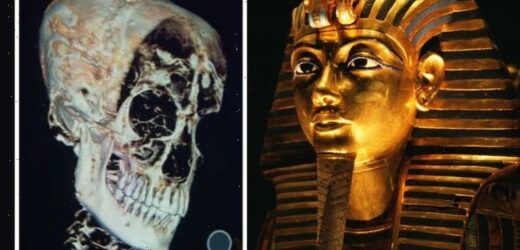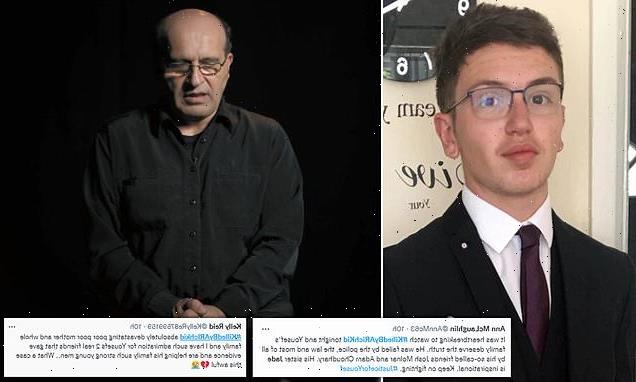Tutankhamun skeleton CT shows 'distinctive skull shape'
We use your sign-up to provide content in ways you’ve consented to and to improve our understanding of you. This may include adverts from us and 3rd parties based on our understanding. You can unsubscribe at any time. More info
Researchers have been drawn to the banks of the River Nile for more than 100 years, each holding the hope that they may find a slice of Egypt’s ancient history. Sir William Matthew Flinders Petrie is considered to be the man who introduced the western world to the North African country’s historical splendours. Locals had been excavating in and around the region for years before him, but when he began his work in the mid-1880s, Europeans began to arrive in their numbers, taking home with them much of what they found.
The Valley of the Kings has been a focal point of Egyptologists’ efforts: a stretch of arid land where, for nearly 500 years from 16th to 11th century BC, rock-cut tombs were excavated for the pharaohs and powerful nobles of the New Kingdom.
By the time western explorers arrived, many of these tombs had long been ransacked by gravediggers and robbers.
One tomb, however, remained in pristine condition, untouched by the looters, and was found by Howard Carter in 1922: the tomb of the great King Tutankhamun.
Compared to the other grandiose burial chambers, Tutankhmaun’s resting place was relatively small and unremarkable, meaning the robbers had overlooked it.


While the boy king has been pored over by Egyptologists, new evidence and details emerge regularly, including those found during Channel 5’s new documentary, ‘Tutankhamun: Waking the Dead’ with Bettany Hughes, which comes out this week.
Questions have remained over what Tutankhamun may have looked like, and whether or not the inbreeding within his family would have passed on to him any disabilities or ailments.
Thanks to the latest cutting-edge CT scans, researchers have stripped Tutankhamun to his bare bones, harnessing crucial data about his physical makeup.
Dr Carolyn Rando, a forensic bioarchaeologist, and her team have created a reconstruction of his body, peeling away the “slices” of his body to search for crucial clues.
Talking about the technology, she said: “It actually means we can go up and down through the layers of the body to look inside in a way that wouldn’t be possible through just external examination or even through taking him apart.”
Spinning the pharaoh’s body to see his side profile, Ms Hughes noted the unusual shape of Tutankhamun’s head, and said: “What you really get a sense of through this is that he’s got quite a distinctive skull shape.”
Dr Rando replied: “He does, this is where it is really incredible.
“He has a very, very long skull compared to most people that we would see today, who would maybe have a more rounded or more bulbous skull.”
JUST IN: Ancient Egypt researchers’ astonishing find in Tutankhamun’s tomb

Ms Huges then noted: “There’s some evidence that this extraordinary skull shape was a trait in his family.
“So, could it also be inbreeding? Could we read that in the skull shape?”
Inbreeding was prevalent among the royal families of Egypt and most royal families around the world.
It can result in things known as congenital disorders that are passed down through familial lines.
These can then cause something called craniosynostosis, which is the premature closure of one or more of the joints that connect the bones of a baby’s skull.
However, Dr Rando was unconvinced that this was the case with Tut, and explained: “But if there was this degree of inbreeding and if there was this [many] possible congenital diseases coming from it, we would actually expect the teeth to change — you would get missing teeth and other teeth would swap positions.”
DON’T MISS
Ancient Egypt breakthrough as body could explain mummification origins [REPORT]
Ancient Egypt discovery took researchers by surprise [INSIGHT]
Egypt mystery blown open over King Tut’s ‘outer space’ dagger [ANALYSIS]


The fact that Tutankhmaun does not have any changes to his teeth suggests that any inbreeding that may have been going on was not that severe or did not cause any serious genetic problems.
Tutankhamun carried on the Egyptian tradition of inbreeding and married his sister, Ankhesenamun.
While it was initially unclear whether they ever had children, the mummified remains of two baby girls were found placed next to him inside his tomb.

It was not until 2008 after their DNA was extracted that researchers determined that the stillborns had belonged to King Tut.
Professor Salima Ikram, an Egyptologist at the American University in Cairo, speaking during the Smithsonian Channel’s documentary, ‘Secrets: Tut’s last mission’, said: “There was such a high mortality rate for infants and children in the ancient world that it’s not surprising.

“But it is extraordinary to have them carefully mummified, wrapped up, cocooned, put in these coffins and placed in their father’s tomb.”
The documentary’s narrator noted: “The tiny mummies are an incredibly rare discovery.”
Tutankhamun: Waking the Dead airs at 9pm March 25 on Channel 5.
Source: Read Full Article


